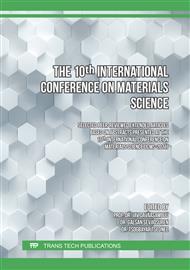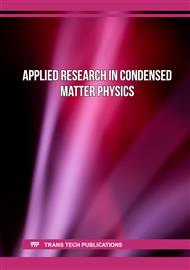[1]
F. Hulliger, Struct. Bonding (Berlin) (1968), p.83.
Google Scholar
[2]
C. I. Pearce, R. A. D. Pattrick, D. J. Vaugham, C. M. B. Henderson and G. van der Laan, Copper oxidation state in chalcopyrite: Mixed Cu d9 and d10 characteristics, Geochim. Cosmochim. Acta Vol. 70 (2006) p.4635.
DOI: 10.1016/j.gca.2006.05.017
Google Scholar
[3]
F. J. DiSalvo, Solid-state chemistry: a rediscovered chemical frontier, Sci. Vol. 247 (1990) p.649.
Google Scholar
[4]
A. P. Alivisatos, Semiconductor clusters, nanocrystals, and quantum dots, Sci. Vol. 271 (1996) p.933.
Google Scholar
[5]
J. R. Heath, P. J. Kuekes, G. S. Snider and R. S. Williams, A defect-tolerant computer architecture: opportunities for nanotechnology, Sci. Vol. 280 (1998) p.1716.
DOI: 10.1126/science.280.5370.1716
Google Scholar
[6]
J. L. Shay and L. H. Wernick, Ternary chalcopyrite semiconductor: growth, electronic properties and applications, (Oxford: Pergamon Press) (1975) p.244.
DOI: 10.1016/b978-0-08-017883-7.50012-3
Google Scholar
[7]
T. Teranishi, K. Sato and K.Kondo, Optical properties of a magnetic semiconductor: chalcopyrite CuFeS2: I. Absorption spectra of CuFeS2 and Fe-doped CuAlS2 and CuGaS2, J. Phys. Soc. Japan Vol. 36 (1974) p.1618.
DOI: 10.1143/jpsj.36.1618
Google Scholar
[8]
S. R. Hall and J. M. Stewart, The crystal structure refinement of chalcopyrite CuFeS2, Acta Crystallogr. Vol. B29 (1973) p.579.
Google Scholar
[9]
I. Kh. Khabibullin, N. N. Garifyanov, and V. L. Matukhin, Special features of the magnetic behaviour of the CuFeS2 semiconductor at low temperatures, Russ. Phys. J. Vol. 51 (2008) p.767.
DOI: 10.1007/s11182-008-9109-z
Google Scholar
[10]
V. V. Klekovkina, R. R. Gainov, F. G. Vagizov, A. V. Dooglav, V. A. Golovanevskiy and I. N. Penkov, Oxidation and magnetic states of chalcopyrite CuFeS2: A first principles calculation, Opt. Spectrosc. Vol. 116 (2014) p.885.
DOI: 10.1134/s0030400x14060149
Google Scholar
[11]
S. Conejeros, P. Alemany, M. Llunell, I. P. R. Moreira, V. Sanchez and J. Llanos, Electronic structure and magnetic properties of CuFeS2, Inorg. Chem. Vol. 54 (2015) p.4840.
DOI: 10.1021/acs.inorgchem.5b00399
Google Scholar
[12]
R. Khaledialidusti, A. K. Mishra and A. Barnoush, Temperature-dependent properties of magnetic CuFeS2 from first-principles calculations: Structure, mechanics, and thermodynamics, AIP Adv. Vol. 9 (2019) p.065021
DOI: 10.1063/1.5084308
Google Scholar
[13]
T. Teranishi, Magnetic and electric properties of chalcopyrite, J. Phys. Soc. Japan Vol. 16 (1961) p.1881.
Google Scholar
[14]
J. C. Woolley, A. M. Lamarche, G. Lamarche, M. Quintero, I. P. Swainson and T. M. Holden, Low temperature magnetic behaviour of CuFeS2 from neutron diffraction data, J. Magn. Magn. Mater. Vol. 162 (1996) p.347.
DOI: 10.1016/s0304-8853(96)00252-1
Google Scholar
[15]
T. E. Engin, A. V. Powell and S. Hull, A high temperature diffraction resistance study of chalcopyrite, CuFeS2, J. Solid State Chem. Vol. 184 (2011) p.2272.
DOI: 10.1016/j.jssc.2011.06.036
Google Scholar
[16]
B. Li, L. Huang, M. Zhong, Z. Wei and J. Li, Electrical and magnetic properties of FeS2 and CuFeS2 nanoplates, RSC Adv. Vol. 5 (2015) p.91103.
DOI: 10.1039/c5ra16918f
Google Scholar
[17]
J. P. Perdew, K. Burke and M. Ernzerhof, Generalized gradient approximation made simple, Phys. Rev. Lett. Vol. 77 (1996) p.3865.
DOI: 10.1103/physrevlett.77.3865
Google Scholar
[18]
P. Hohenberg and W. Kohn, Inhomogeneous electron gas, Phys. Rev. Vol. 136 (1964) p. B864.
DOI: 10.1103/physrev.136.b864
Google Scholar
[19]
W. Kohn and L. J. Sham, Self-consistent equations including exchange and correlation effects, Phys. Rev. Vol. 140 (1965) p. A1133.
DOI: 10.1103/physrev.140.a1133
Google Scholar
[20]
P. Gianmozzi, S. Baroni, N. Bonini, M. Calandra, R. Car, C. Cavazaaoni, D. Ceresoli, G. L. Chiarotti, M. Cococcioni, I. Dabo, A. D. Corso, S. de Gironcoli, S. Fabris, G. Fratesi, R. Gebauer, U. Gerstmann, C. Gougoussis, A. Kokalj, M. Lazzeri, L. Martin-Samos, N. Marzari, F. Mauri, R. Mazzarello, S. Paolini, A. Pasquarello, L. Paulatto, C. Sbraccia, S. Scandolo, G. Sclauzero, A. P. Seitsonen, A. Smogunov, P. Umari and R. M. Wentzcovich, QUANTUM ESPRESSO: a modular and open-source software project for quantum simulations of materials, J. Phys.: Condens. Matter. Vol. 21 (2009) p.395502
DOI: 10.1088/0953-8984/21/39/395502
Google Scholar
[21]
P. Giannozzi, O. Andreussi, T. Brumme, O. Bunau, M. Buongiorno Nardelli, M. Calandra, R. Car, C. Cavazzoni, D. Ceresoli, M. Cococcioni, N. Colonna, I. Carnimeo, A. D. Corso, S. de Gironcoli, P. Delugas, R. A. DiStasio Jr, A. Ferretti, A. Floris, G. Fratesi, G. Fugallo, R. Gebauer, U. Gerstmann, F. Giustino, T. Gorni, J. Jia, M. Kawamura, H. -Y. Ko, A. Kokalj, E. Kucukbenli, M. Lazzeri, M. Marsili, N. Marzari, F. Mauri, N. L. Nguyen, H. -V. Nguyen, A. Otero-de-la- Roza, L. Paulatto, S. Ponce, D. Rocca, R. Sabatini, B. Santra, M. Schlipf, A. P. Seitsonen, A. Smogunov, I. Timrov, T. Thonhauser, P. Umari, N. Vast, X. Wu and S. Baroni, Advanced capabilities for materials modelling with Quantum ESPRESSO, J.Phys.: Condens. Matter. Vol. 29 (2017) p.465901
DOI: 10.1088/1361-648x/aa8f79
Google Scholar
[22]
P. Giannozzi, O. Baseggio, P. Bonfa, D. Brunato, R. Car, I. Carnimeo, C. Cavazzoni, S. de Gironcoli , P. Delugas, F. F. Ruffino, A. Ferretti, N. Marzari, I. Timrov, A. Urru and S. Baron, Quantum ESPRESSO toward the exascale, J. Chem. Phys. Vol. 152 (2020) p.154105.
DOI: 10.1063/5.0005082
Google Scholar
[23]
D. Vanderbilt, Soft self-consistent pseudopotentials in a generalized eigenvalue formalism, Phys. Rev. B Vol. 41 (1990) p. R7892.
DOI: 10.1103/physrevb.41.7892
Google Scholar
[24]
A. D. Corso, Pseudopotentials periodic table: from H to Pu, Comput. Mater. Sci. Vol. 95 (2014) p.337.
Google Scholar
[25]
H. J. Monkhorst and J. D. Pack, Special points for Brillouin-zone integration, Phys. Rev. B Vol. 13 (1976) p.5188.
DOI: 10.1103/physrevb.13.5188
Google Scholar
[26]
P. E. Blochl, O. Jepsen and O. K. Andersen, Projector augmented-wave method, Phys. Rev. B Vol. 49 (1994) p.16223.
Google Scholar
[27]
M. C. Payne, M. P. Teter, D. C. Allan, T. A. Arias and J. D. Joannopoulos, Iterative minimization techniques for ab initio total energy calculations: molecular dynamics and conjugate gradients, Rev. Mod. Phys. Vol. 64 (1992) p.1045.
DOI: 10.1103/revmodphys.64.1045
Google Scholar
[28]
M. Cococcioni and S. de Gironcoli, Linear response approach to the calculation of the effective interaction parameters in the LDA+U method, Phys. Rev. B Vol. 71 (2005) p.035105.
DOI: 10.1103/physrevb.71.035105
Google Scholar
[29]
G. Autes, C. Barreteau, D. Spanjaard and M. Desjonqueres, Magnetism of iron: from the bulk to the monatomic wire, J. Condens. Matter Phys. Vol. 18 (2006) p.6785.
DOI: 10.1088/0953-8984/18/29/018
Google Scholar
[30]
D. Li, A. Smogunov, C. Barreteau, F. Ducastelle, and D. Spanjaard, Magnetocrystalline anisotropy energy of Fe(001) and Fe(110) slabs and nanoclusters: A detailed local analysis within a tight-binding model, Phys. Rev. B Vol. 88 (2013) p.214413.
DOI: 10.1103/physrevb.88.219908
Google Scholar
[31]
D. Li, C. Barreteau, M. R. Castell, F. Silly, and A. Smogunov, Out- versus in-plane magnetic anisotropy of free Fe and Co nanocrystals: Tight-binding and first-principles studies, Phys. Rev. B Vol. 90 (2014) p.205409.
DOI: 10.1103/physrevb.90.205409
Google Scholar
[32]
X.B. Liu, Z. Altounian and D. H. Ryan, Magnetocrystalline anisotropy in Gd(Co,Fe)12B6: A first-principles study, J. Alloys Compd. Vol. 688 (2016) p.188.
DOI: 10.1016/j.jallcom.2016.07.143
Google Scholar
[33]
N. N. Sirota and Zh. K. Zhalgasbekova, Root-mean-square displacements of ions and characteristic temperatures of chalcopyrite according to X-ray data at 5–300 K, Dokl. Akad. Nauk SSSR Vol. 321 (1991) p.513.
Google Scholar
[34]
T. Jungwirth, X. Marti, P. Wadley and J. Wunderlich, Antiferromagnetic spintronics, Nat. Nanotechnol. Vol. 11 (2016) pp.231-241.
DOI: 10.1038/nnano.2016.18
Google Scholar
[35]
B. He, Z. Bao, K. Zhu, W. Feng, H. Sun, N. Pang, N. Tsogbadrakh and D. Odkhuu, Itinerant semiconducting antiferromagnetism in metastable V3Ga, Phys. Status Solidi RRL Vol. 13 (2019) p.1900483.
DOI: 10.1002/pssr.201900483
Google Scholar
[36]
G. Donnay, L. M. Corliss, J. D. H. Donnay, N. Elliott and J. M. Hastings, Symmetry of magnetic structures: magnetic structure of chalcopyrite, Phys. Rev. Vol. 112 (1958) p.1917.
DOI: 10.1103/physrev.112.1917
Google Scholar



